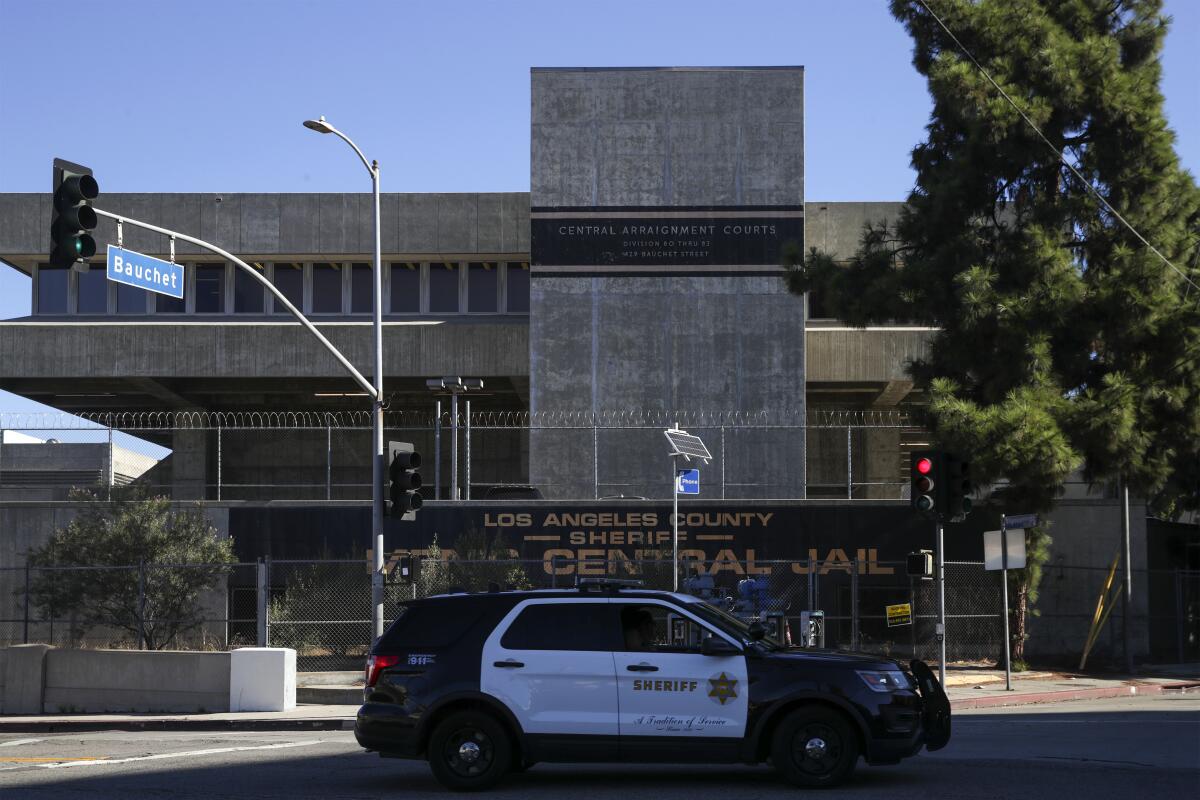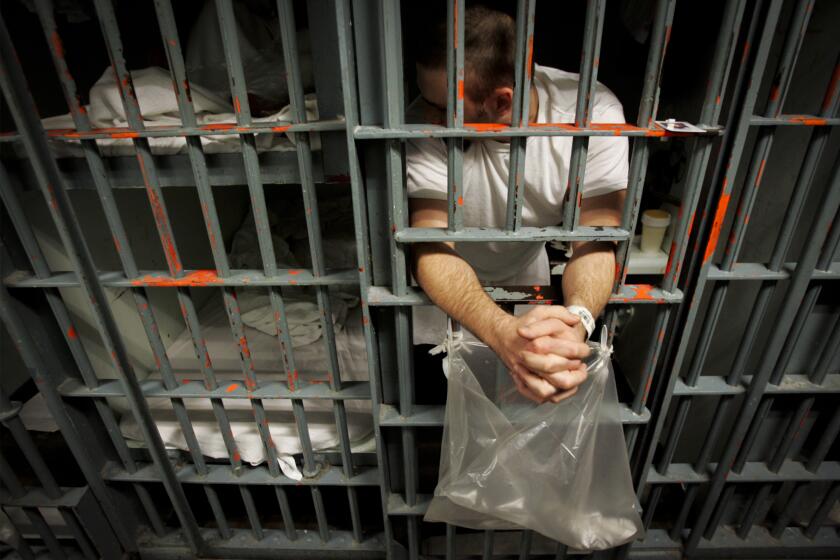Oversight inspectors accuse Sheriff’s Department of retaliation after reports on jail fires

Oversight commissioners have repeatedly accused the Los Angeles County Sheriff’s Department of retaliating against inmates at Men’s Central Jail after inspectors called attention to the ongoing problem of fires burning unchecked inside the decrepit downtown lockup.
For years, inmates have been using batteries, razors, toilet paper and other items to set blazes when they want to cook food or heat water. But last summer, oversight inspectors — alarmed by three particularly large fires they’d witnessed — drew attention to the issue in commission reports and public meetings.
Afterward, a Times investigation found the problem stretched back several decades and was possible in part because the inmate housing areas in the aging facility have no sprinklers to douse blazes or blaring smoke detectors to prompt jailers to respond.
Then, in a move Sybil Brand Commission members Eric Miller and Mary Veral told The Times last month was “retaliatory,” jail officials confiscated batteries that high-security inmates in isolation used to listen to their radios.
Inmates responded with a hunger strike that department officials said has since ended. The fires, however, have not.
In Men’s Central Jail, they say, there is almost always something burning. But there are no smoke alarms where inmates live.
“It still smelled like fires, but they’re not doing anything about them — they’re just taking away the batteries,” Veral told The Times after a visit to the jail this week. “I’m pretty sure you can light fires other ways.”
The Sheriff’s Department did not deny the accusations of retaliation but told The Times that the battery-powered radios had only been available as part of a pilot program. The department did not explain how fires were set in the years before the pilot program made battery-powered radios available to inmates. Officials are now exploring radio alternatives that do not require batteries, the department said.
“The safety of the inmates in our custody is our highest priority,” the department said in a statement. “Regular searches are conducted in all inmate housing areas in an attempt to locate any outstanding batteries or other ignition sources.”
Though the recent concerns about fires have brought the issue to the fore, blazes have been a problem in Los Angeles County lockups for more than a century. In 1921, the former county jail descended into an 18-hour riot after one man started a fire to heat his coffee and jailers responded by placing him in solitary confinement. That unrest helped prompt the construction of another jail; it was eventually condemned in part because the shortage of emergency exits made it a firetrap.
When Men’s Central Jail opened in 1963, building codes still did not require automatic sprinklers or smoke detectors in any of the housing areas. Instead, the facility relied on a manually triggered alarm system, trusting the jail staff to spot fires and alert people. Though there have been some upgrades, jail officials previously told The Times that is largely how the system still works today.
In the decades since Men’s Central Jail opened, inmates have regularly set fires for a variety of reasons. Several former inmates have told The Times that people use fires to cook their food, though sometimes they also use them to heat their water, stay warm or smoke cigarettes and drugs.
During an inspection by members of the Sybil Brand Commission in June, Veral said she spotted three large blazes on the second floor of the downtown facility. When she alerted jailers to the problem, Veral said, they shrugged and told her the inmates were cooking their canteen food and there wasn’t much the guards could do about it.
Some lockups facing similar fire problems elsewhere have tried to tackle the issue by getting money for smoke detectors and more robust fire alarm systems. In Texas, a 2020 investigation by the Marshall Project, a nonprofit news site, found that the prison system had been violating state fire safety regulations for more than a decade and that men incarcerated there were regularly starting blazes to attract the attention of guards who they said ignored their needs.
After that reporting, the prison system more than tripled its spending on fire alarms. Before those installations were completed, further reporting found that several prisoners died in cell fires. This week, a prison spokeswoman confirmed that the state has again bumped up its fire safety spending to more than $13 million in 2024. She also confirmed to The Times that inmates in Texas are still allowed to have radios.
Yet Los Angeles has handled its fire hazards differently, as oversight inspectors detailed in a report last month.
“In June 2023 SBC commissioners witnessed fires in cells and brought the issue to the attention of [the L.A. County Sheriff’s Department] in hopes they would take steps to ensure the safety of people incarcerated and working inside of Men’s Central Jail,” the report said. “LASD has not done anything to address the issue except to take away batteries from everyone incarcerated in the jail except a few people.”
For the men living in isolation on the third floor — which is not the same floor where commissioners reported fires in June — the report said the radios “are one of the few things they can purchase to help with their mental health by providing music and entertainment while they are confined in their cell.”
The report went on to question why department officials thought “prohibiting the purchase of batteries was the only possible response to the issue of fires,” instead suggesting that officials consider more frequent inspections to determine the source of the fires.
At a public meeting last month, Miller described the move as “retaliation by the Sheriff’s Department who, instead of ensuring that [inmates] get hot meals, have taken away batteries.”
In responses to questions from The Times, the Sheriff’s Department said its decision to take away batteries stemmed from the outcome of arson investigations that determined batteries had been the ignition point for recent fires on the third floor and elsewhere in the jail.
Officials also said the pilot program to allow inmates radio access — something that has been common in jails and prisons across the country for decades — started in 2017 and only expanded to the third floor this year.
The program was determined “not to be successful,” in part because the “antiquated and unique physical layout” of Men’s Central Jail “created challenges,” the department said. “Nonetheless, these factors continue to be evaluated in our efforts to identify opportunities to expand services to our inmate population, in the safest manner possible.”
More to Read
Sign up for Essential California
The most important California stories and recommendations in your inbox every morning.
You may occasionally receive promotional content from the Los Angeles Times.












